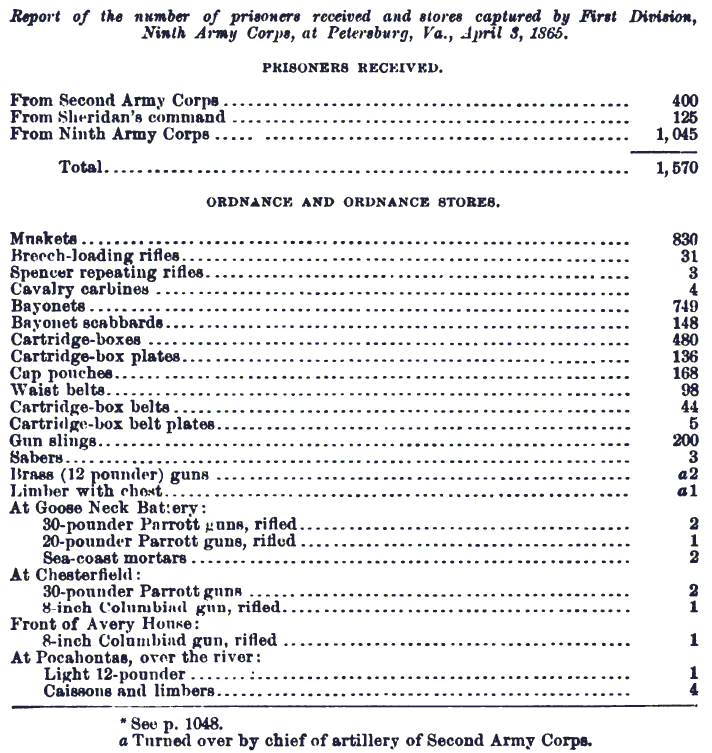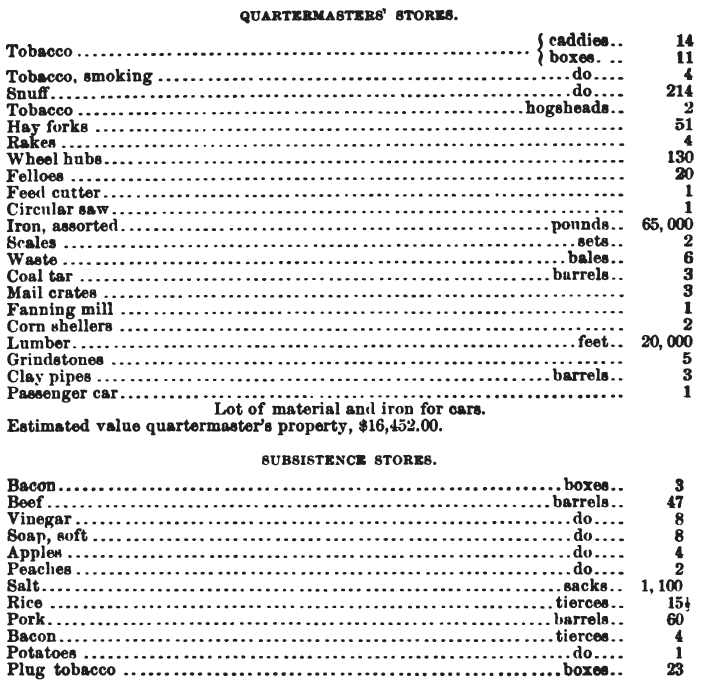No. 154. Report of Bvt. Major General Orlando B. Willcox, U. S. Army, commanding First Division.1
HEADQUARTERS FIRST DIVISION, NINTH ARMY CORPS,
Washington, D. C., May 16, 1865.
MAJOR: I have the honor to report the operations of this division in the field from the 29th of March to the 9th of April, 1865, inclusive:
On the night of the 29th of March, at 10.30 o’clock, the enemy opened on my lines, stretching from Fort Morton to the Appomattox, with all their artillery of every description, and some musketry from their main lines. At about 11 o’clock the artillery lulled. I expected an advance of the enemy’s troops, and was ready to receive them, but no attack was made, and a desultory firing of artillery only continued through the night. It afterward appeared, from the official reports of the enemy, that they thought we had made an attack; in fact, Major-General Gordon reported such to be the case, and that they had handsomely repulsed us. But although we were under orders from corps headquarters to be ready to attack, and I had caused to be distributed axes for cutting the enemy’s abatis, yet no sort of attack was actually ordered or made on our part.
The sensitiveness of the enemy seemed to encourage our men. Preparations were made on the 31st, as well as on April 1, for a night attack opposite Forts Haskell and Stedman, Third Brigade, and at a point in front of Ely’s brigade, nearer the Appomattox. Through the night of the 2nd various threatening demonstrations were made along the line, and the enemy’s picket-pits captured at various points, in pursuance of orders from corps headquarters, made in aid of operations being carried on the left of the army.
At about 1 o’clock on the morning of the 2nd of April orders were received from corps headquarters to mass one brigade, except garrisons by 4 o’clock on the same morning near Fort Sedgwick, on the Second Division front, where General Hartranft was to make a real attack with his division and a brigade from each of the other divisions, while by the same order I was directed to make a vigorous demonstration along my whole division line with the rest of my troops at the same hour. Colonel Harriman was accordingly detached with staff officers who knew the road, tools, ammunition, and every possible aid, to report to General Hartranft, and this brigade was in position and formed at the moment required.
The demonstration ordered along the line began precisely at 4 by the Second Brigade, Bvt. Colonel Ralph Ely; Third Brigade, Bvt. Colonel G. P. Robinson, and Colonel William J. Bolton, commanding Fifty-first Pennsylvania, left on the First Brigade line of intrenchments. Some of the enemy’s
picket-pits were captured near the old Crater by Colonel Bolton. The pickets of the Third and Second Brigades, strongly re-enforced, advanced handsomely, the artillery opened vigorously, and large portions were drawn down to oppose what they considered a real attack in force.
On the extreme right, near the Appomattox, a portion of Ely’s brigade actually carried some 200 yards of the enemy’s works, but our lines, two miles in length, were too much attenuated to hold the ground. Some seventy-five prisoners were secured and brought in. Three regiments were withdrawn from other points and double-quacked to the point but before it could be re-enforced the enemy recovered it.
The effect of this movement, however, on the general result was most happy, inasmuch as it contributed to weaken the enemy’s line in front of Fort Sedgwick, where the real attack was completely successful. For this handsome part performed by Harriman’s brigade of this division at the latter point I respectfully refer you to his own report and that of Brevet Major-General Hartranft, commanding at that part of the line.
Through the day offensive demonstrations were kept up and the batteries playing in aid of the more serious work of the day going on farther to our left. In the afternoon and evening the enemy strengthened their line opposite me, but about midnight of the 2nd reports came up from Colonel Ely, commanding Second Brigade, and Colonel James Bintliff, now commanding Third Brigade, by virtue of his rank, that there were signs of the enemy withdrawing from our front, leaving only their picket-line. I gave orders to the two brigade commanders to press through as soon as possible.
At about 2 o’clock on the morning of the 3rd some of our parties broke through Bintliff’s brigade, advanced upon Cemetery Hill, and Ely more directly into the town with a section of Stone’s battery. I gave Colonel Ely orders to take measures at once to secure order in the city. At 4.28 a.m. one of his flags, that of the First Michigan Sharpshooters, was raised on the court-house, and that of the Second Michigan on the custom-house. A few minutes later and guards were posted about the town. The enemy had fired the bridges, but with the aid of the negroes, who manned the fire-engines, our troops extinguished the flames in time to save the main structures, and skirmishers were at once pushed across the river, picking up stragglers and other prisoners.
General Benham, commanding a brigade from City Point, who had taken post the night before in rear of my lines, entered the city with me and allowed me the use of a detachment of 200 cavalry, part of which patrolled the town and part were sent across the river, on a reconnaissance, to learn the direction of the enemy’s main route of retreat, which duty was performed correctly, and reported to the lieutenant-general commanding the armies, who early advanced into the town in person. In two hours, notwithstanding the presence of troops from every corps, including colored troops, Petersburg, which had been besieged by our army nearly ten months, was as quiet, and property and persons as safe as in Washington, an instance of discipline and good conduct on the part of troops unsurpassed in military history.
The number of prisoners captured on this and the following day, by scouring the country with scouting parties, was 1,045; number of muskets, 830; number of flags, 7 (forwarded to City Point, to headquarters Armies of the United States); value of quartermaster’s and subsistence stores, $20,000.
The division remained in Petersburg guarding the railroad two days, when by orders from corps headquarters we moved up to Sutherland’s Station, on South Side Railroad, and connecting there with the Third Division moved up along the railroad as the army advanced, until the 9th of April, when we stretched from Sutherland’s to Wellville.
For details of operations of the respective regiments of the division I respectfully refer you to accompanying reports of the brigade commanders, and commend their notice of gallant officers and men to the approval of the major-general commanding the corps for brevet appointments.
Accompanying the Second Brigade report is the document of the city authorities surrendering the city of Petersburg to Colonel Ely.*
O. B. WILLCOX,
Brevet Major-General, Commanding.
Bvt. Major JOHN D. BERTOLETTE,
Asst. Adjt. General 9th Army Corps and Dist. of Alexandria.
ADDENDA.
Report of the number of prisoners received and stores captured by First Division, Ninth Army Corps, at Petersburg, Va., April 3, 1865.

—————
* See p.1048.
a Turned over by chief of artillery of Second Army Corps.
—————

Source:

